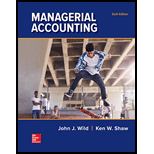
Managerial Accounting
6th Edition
ISBN: 9781259726972
Author: John J Wild, Ken W. Shaw, Barbara Chiappetta Fundamental Accounting Principles
Publisher: McGraw-Hill Education
expand_more
expand_more
format_list_bulleted
Question
Chapter B, Problem 5E
To determine
Present Value:
Present value of money means the present or current value of a future
Future Value:
The future value is the value of present cash flow at specified time period and at specified
We have to determine the amount to be received after 10 years.
Expert Solution & Answer
Want to see the full answer?
Check out a sample textbook solution
Students have asked these similar questions
Please explain the solution to this financial accounting problem using the correct financial principles.
Provide Answer
Braylon Manufacturing has beginning work in process inventory of $125,000 and total manufacturing costs of $740,000. If the cost of goods manufactured is $710,000, what is the cost of the ending work in process inventory?
Knowledge Booster
Similar questions
- Taxpayer has a warehouse where she acquired equipment for $24,000. Over time, depreciation of $15,000 was claimed. In the current year, taxpayer sells the asset for $28,000. What is the amount and nature of the gain/loss from the sale? A. $15,000 of ordinary income, $4,000 long term capital gain B. $19,000 longterm capital gain C. $4,000 of long-term capital gain, 12,000 of ordinary income D. $19,000 ordinary incomearrow_forwardEstefan, Inc. produces a product that has a variable cost of $8.00 per unit. The company's fixed costs are $75,000. The product is sold for $12.50 per unit and the company desires to earn a target profit of $45,000. What is the amount of sales that will be necessary to earn the desired profit?arrow_forwardHow does operational efficiency measurement differ from financial metrics? a) Process effectiveness indicators complement cost measures b) Financial data tells complete story c) Efficiency remains constant d) Standard metrics work everywherearrow_forward
- Summit Gear Co. estimates its manufacturing overhead to be $620,000 and its direct labor costs to be $1,000,000 for year 1. The first three jobs that Summit Gear worked on had actual direct labor costs of $31,000 for Job 401, $42,000 for Job 402, and $53,000 for Job 403. For the year, actual manufacturing overhead was $600,000 and total direct labor cost was $970,000. Manufacturing overhead is applied to jobs on the basis of direct labor costs using predetermined rates. How much overhead was assigned to each of the three jobs, 401, 402, and 403?arrow_forwardWhat amount of gain does he have to report on this sale?arrow_forwardCapwell Enterprises acquired a patent on March 15, 2023. Capwell paid cash of $58,000 to the seller. Legal fees of $3,200 were paid related to the acquisition. What amount should be debited to the patent account?arrow_forward
- Jackman Corporation sells its product for $25 per unit. Next year, fixed expenses are expected to be $385,000 and variable expenses are expected to be $13 per unit. How many units must the company sell to generate a net operating income of $110,000?arrow_forwardI need help with this general accounting question using the proper accounting approach.arrow_forwardPedro owns securities with a tax basis of $8,300. He gives them to Rivera when they are worth only $6,500. Rivera held these securities until they were worth$9,800 and sold them. What amount of gain does he have to report on this sale? a) $1,500 b)$3,300 c) $850 d) $2,400arrow_forward
- How much of the packing cost pool should be assigned to bath mats ?arrow_forwardCan you explain the correct methodology to solve this general accounting problem?arrow_forwardIf Salaries and Wages Expense is $536,800 during the year and the beginning and ending balances of Salaries and Wages Payable are $32,400 and $28,900, respectively, the cash paid to employee’s is__.arrow_forward
arrow_back_ios
SEE MORE QUESTIONS
arrow_forward_ios
Recommended textbooks for you
 EBK CONTEMPORARY FINANCIAL MANAGEMENTFinanceISBN:9781337514835Author:MOYERPublisher:CENGAGE LEARNING - CONSIGNMENT
EBK CONTEMPORARY FINANCIAL MANAGEMENTFinanceISBN:9781337514835Author:MOYERPublisher:CENGAGE LEARNING - CONSIGNMENT Pfin (with Mindtap, 1 Term Printed Access Card) (...FinanceISBN:9780357033609Author:Randall Billingsley, Lawrence J. Gitman, Michael D. JoehnkPublisher:Cengage Learning
Pfin (with Mindtap, 1 Term Printed Access Card) (...FinanceISBN:9780357033609Author:Randall Billingsley, Lawrence J. Gitman, Michael D. JoehnkPublisher:Cengage Learning Intermediate Accounting: Reporting And AnalysisAccountingISBN:9781337788281Author:James M. Wahlen, Jefferson P. Jones, Donald PagachPublisher:Cengage LearningPrinciples of Accounting Volume 2AccountingISBN:9781947172609Author:OpenStaxPublisher:OpenStax College
Intermediate Accounting: Reporting And AnalysisAccountingISBN:9781337788281Author:James M. Wahlen, Jefferson P. Jones, Donald PagachPublisher:Cengage LearningPrinciples of Accounting Volume 2AccountingISBN:9781947172609Author:OpenStaxPublisher:OpenStax College Financial Accounting: The Impact on Decision Make...AccountingISBN:9781305654174Author:Gary A. Porter, Curtis L. NortonPublisher:Cengage Learning
Financial Accounting: The Impact on Decision Make...AccountingISBN:9781305654174Author:Gary A. Porter, Curtis L. NortonPublisher:Cengage Learning

EBK CONTEMPORARY FINANCIAL MANAGEMENT
Finance
ISBN:9781337514835
Author:MOYER
Publisher:CENGAGE LEARNING - CONSIGNMENT

Pfin (with Mindtap, 1 Term Printed Access Card) (...
Finance
ISBN:9780357033609
Author:Randall Billingsley, Lawrence J. Gitman, Michael D. Joehnk
Publisher:Cengage Learning


Intermediate Accounting: Reporting And Analysis
Accounting
ISBN:9781337788281
Author:James M. Wahlen, Jefferson P. Jones, Donald Pagach
Publisher:Cengage Learning

Principles of Accounting Volume 2
Accounting
ISBN:9781947172609
Author:OpenStax
Publisher:OpenStax College

Financial Accounting: The Impact on Decision Make...
Accounting
ISBN:9781305654174
Author:Gary A. Porter, Curtis L. Norton
Publisher:Cengage Learning